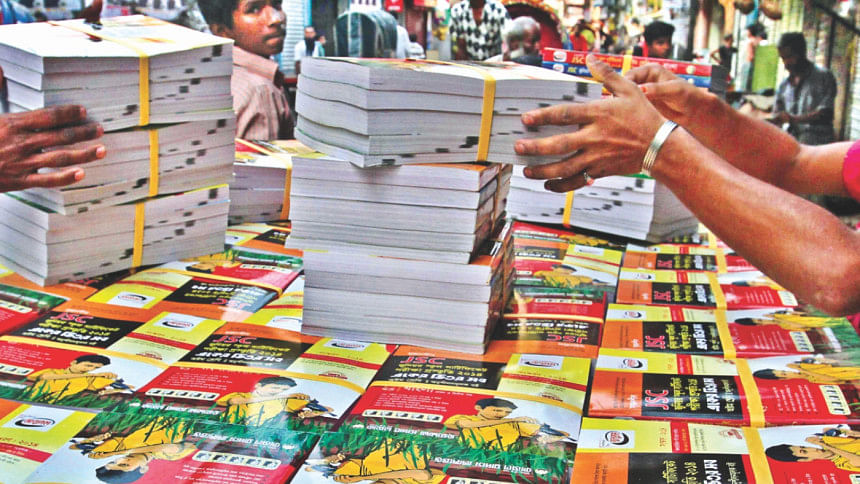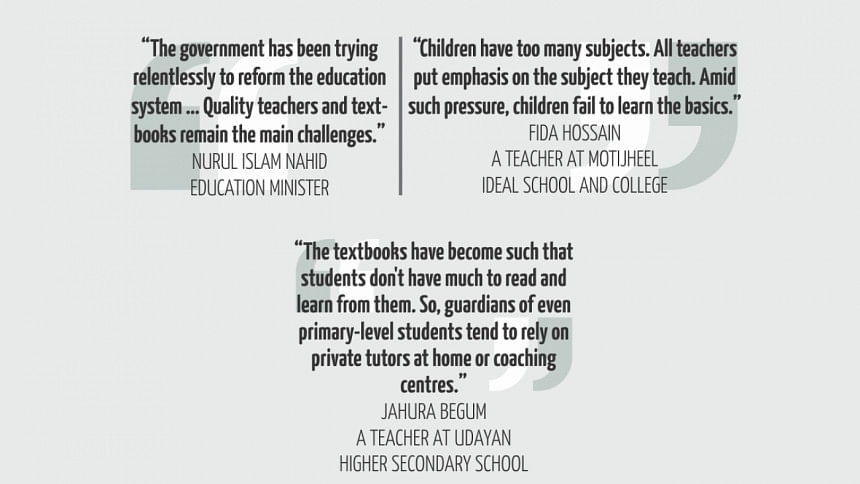Textbooks not up to the mark

Ishaan pulls out three books on Bangladesh and Global Studies, as he explains how he has been preparing for his final exams in class-VI.
Two of them are actually guidebooks which he says are must-read study materials for excelling in the subject.
The 12-year-old boy, who lives in the capital's Tikatuli, was first advised to read guidebooks as early as class-III. And the advice came from none other than his school teachers and private tutors at home.
With the passing of each academic level, he says, he grows more dependent on guidebooks.
This is not a picture unique to Ishaan.
Talking to more than a dozen students, parents and teachers, The Daily Star found that students follow guidebooks more than they follow textbooks given for free up to the secondary level on the very first day of every academic year.
One of the major reasons behind this is that textbooks are so abridged that learners fail to get the essence of the topics.
For example, the chapters on the Liberation War for class-V include lists of 11 sectors, in which the then East Pakistan was divided to organise the fight against the Pakistan army; significant movements prior to the Liberation War; and names of a few martyrs known for their sacrifices.
But they fail to provide the context that pushed the Bangalees into the war and how one socio-political event led to another. Those are left for students to discuss with teachers.
The National Education Policy 2010 recommends interactive teaching method to encourage students to do exercises through individual or group work.

Since schools have limited time and resources, and teachers limited knowledge, it is difficult and not always possible to engage students in discussions and acquire more information to understand the subjects better, said teachers at both primary and secondary levels.
So, they choose guidebooks as a shortcut to good results.
Teachers also complain that coherence is absent between contents and exercises, and between textbooks for one academic level and those for the next.
The aim of introducing creative method to education was to give children enough knowledge in sync with their level of maturity on a topic so they can answer questions based on their understanding.
However, contents in textbooks have been reduced drastically to keep the academic pressure on children low. That in reality leads them to take help of guidebooks to pass exams.
Besides, textbooks have been so condensed that teachers find it difficult to set questions in the four segments -- knowledge, understanding, application and higher ability -- introduced in the new system.
When children get scanty and disjointed information, they fail to build their own perception of what they read about. This makes harder for teachers as well to test children's understanding and higher ability.
Explaining the situation, Jahura Begum, a senior teacher at Udayan Higher Secondary School in the capital, said students have less to read and learn from textbooks and more to discuss with teachers. Thus children's education has become more dependent on how much teachers can deliver.
But teachers across the board are not equally capable. So, for good results in exams, students and guardians seek ready materials from guidebooks or coaching centres, according to the science teacher.
Also, several teachers who received training more than once said they were not suggested any reference books they could use to teach in detail the topics written in brief in textbooks.
The problems facing students in remote areas are of different dimensions.
Shamim Hossain, a teacher at Jagusha Government Primary School in Jhenidah's Maheshpur, said almost all 156 students of the school, nationalised in 1973, were born to parents with little or no education. Apart from school teachers and textbooks, they have no access to other sources of learning.
Over the time, he has observed that children find it hard to get the message of textbooks as they tend to forget much of class lectures. They then become reluctant to study.
Three other teachers in city schools echoed his view. Besides, they pointed out mistakes in the books. Like, the world's most populous continent Asia has 27 countries according to the textbook for class-VII while the number is put at 51 in the textbook for class-VI.
“Textbooks have become more like pamphlets,” said Jahura Begum, adding that those were not written with much sincerity either.
Flipping through the science textbook of class-V, she pointed out that pollution is discussed in several chapters -- one on environmental pollution and others specifically on water and air. However, those chapters could have been put together for the students' better understanding.
Fida Hossain, a senior mathematics teacher at Motijheel Ideal School and College, has another point to make.
Some textbook chapters have exercises without similar examples explaining how to solve them. Though teachers at classes of 70-80 students demonstrate how to do those exercises, except for a handful of brilliant or more mature students, the majority need further guidance back home.
A teacher of the primary level, Mousumy Shill, said if academic pressure on students is all that the authority is concerned about, then why subjects in class-VI total 13, more than double the number of those for just one class down.
While studying too many subjects, children can hardly manage time to gain in-depth knowledge of the basic subjects, Fida Hossain said.
It is reflected in a government survey on children of class-VI and class-VIII.
According to the Learning Assessment of Secondary Education, 2015, 51 percent eighth graders didn't have expected level of competency in English while 46 percent in mathematics and 45 percent in Bangla. The condition of sixth graders was somewhat better, as 71 percent were found competent in English, 70 percent in Bangla and 77 percent in mathematics.
Sankar Debnath, a teacher at Blue Bird Kindergarten in Comilla's Kurbanpur village, said the public examinations start as early as class-V, and this is one of the main reasons why guardians and teachers put emphasis on results rather than quality education.
Teachers of Bangladesh International School and College in the capital, where 11-year-old Rheed studies in English version, don't follow guidebooks. Instead, they prepare question-answer sheets and give those to students.
Rheed memorised and revised again and again the answers in the sheets he received from class teachers to prepare for Primary School Certificate exams that ended on November 27.
This rote learning is exactly what the education ministry wanted to discourage when it adopted the creative method in 2008.
Under the new system, which aims to help students develop their creativity and thinking ability, students first took public exams -- Secondary School Certificate exams -- in 2010.
Six years have gone by, but except for a handful of institutions, most schools have remained confined to the old method tucked under the mask of the new one.
“All schools in this area follow guidebooks,” said Sankar, who founded Blue Bird Kindergarten in Comilla 18 years back. And he claims success in running the school as most of its students have been passing public exams with flying colours.
Looking for ways to learn how to answer creative questions, Fardin, a student of class-VII at Motijheel Ideal, has started attending a coaching centre but there, he says, he gets sheets of study materials for all subjects except mathematics.
“The coaching helps us prepare for exams, and shows us how to score high marks,” Fardin says.
As to how the new system in place can ensure better education, Asadul Alam, assistant professor of chemistry at Udayan that has around 3,500 students, said textbooks should be valuable sources of information, since leaving everything to teachers would be like depriving students who don't have access to resources of knowledge.
Questions can be set in a creative way to test the clarity of students' concepts of the subjects, he added.
Theoretically, experts are supposed to take into account opinions and observations of teachers while bringing out textbooks. But that rarely happens, said science teacher Jahura.
Acknowledging that, Rasheda K Choudhury, executive director of the Campaign for Popular Education, said experts wrote textbooks without keeping child psychology in mind. To make things interesting, they should go down to the level of children and write in their language.
The primary education has been improved to a great extent, said Rasheda, adding that secondary-level education has, however, many hurdles to overcome.
Talking to The Daily Star, Education Minister Nurul Islam Nahid said the government has been trying relentlessly to reform the education system. In that endeavour, quality teachers and textbooks remain the main challenges.
[The Daily Star didn't mention the full names of the students at the request of their guardians]

 For all latest news, follow The Daily Star's Google News channel.
For all latest news, follow The Daily Star's Google News channel. 



Comments